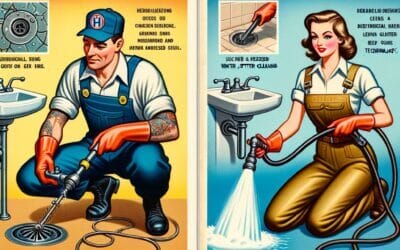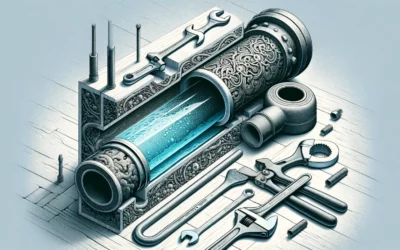Welcome to our comprehensive guide on “Understanding Red Tags on Water Heaters: Insights from Experts.” This blog post will enlighten you with invaluable factual information sourced directly from industry professionals. Whether you’re a homeowner looking to troubleshoot your water heater issues or simply an individual seeking knowledge, this article will serve as an exceptional tool. We delve into the significance of red tags on water heaters, helping you comprehend what they mean, why they are used, and how you can respond to them. Gain insights from the experts and confidently handle your water heater concerns. Take the first step towards becoming more informed – enjoy a seamless, easy, informative, and most importantly, useful reading experience! Enjoy peace of mind knowing you’re taking advice from the industry’s best. Happy reading!
Understanding the Purpose of Red Tags on Water Heaters
While it’s common to see water heaters in many homes, not everyone is familiar with the notion of red tags that may accompany these essential household appliances. Red tags are not added frivolously; they serve a very crucial purpose. Essentially, red tags are put in place by gas inspectors when they identify a gas appliance as a potential hazard. If your water heater has been red-tagged, it means the unit is not operating safely and could pose a danger typically related to carbon monoxide leakage.
There are two types of red tags that you might see on your water heater; Type ‘A’ and Type ‘B’.
- Type ‘A’ Red Tags: These are issued immediately after a critical safety violation has been detected that can pose an immediate threat. If you receive a type ‘A’ red tag, gas supply to your water heater, and possibly your entire house will be shut off instantly.
- Type ‘B’ Red Tags: These are usually issued when there is a safety concern that is not immediately dangerous. Once a type ‘B’ red tag is issued, the homeowner usually has a timeline (generally up to 45 days) to rectify the situation. If the problem is not addressed within the given timeline, the gas supply can be cut off.
While the mention of ‘red tags’ could stir up panic, it’s important to note that they are a safety measure put in place for your protection. The right way to approach this predicament is by prompt action. Hire a licensed professional, who would understand the seriousness of the red-tagged situation, run thorough checks on your water heater, and perform necessary repairs or replacements to restore the safety of your home, thereby getting the red tag lifted.
Decoding What Heaters’ Red Tags Signify
To many homeowners, the sight of a red tag on their water heaters can initially create confusion, and sometimes panic. Fear not, the objective of this article is to decode what these red tags actually represent and why they are attached to your water heater. Let’s delve in!
What Do Red Tags Signify?
A red tag, simply put, is a safety device which is affixed by your technician on your water heater, implying that it is malfunctioning and can pose a serious safety hazard if not addressed promptly. We’ve compiled a list of the main reasons why a water heater might be red tagged, which includes:
- Incorrect Installation: This could mean your water heater was installed improperly, using wrong fittings or flue piping, which can lead to dangerous situations like carbon monoxide leaks.
- Gas Leaks: Your unit may have a severe issue with uncontrolled gas leakage, which can result in deadly explosions if ignited.
- Faulty Venting: Improper or faulty venting can cause dangerous levels of carbon monoxide to build up inside your home.
The table below summarizes the key points and actions needed when a red tag appears on your water heater:
| Red Tag Issue | Action Needed |
|---|---|
| Incorrect Installation | Seek immediate professional help to correct installation. |
| Gas Leaks | Vacate property immediately and call gas company/technician. |
| Faulty Venting | Turn off the heater and get your vents checked by professionals. |
Remember, a red tag is paramount to your safety. Always contact a licensed professional to addresses any highlighted issues before removing the red tag. Paying close attention to these small details can potentially save the lives of your loved ones and avoid costly damages to your property. Stay safe, folks!
When and Why Experts Place Red Tags on Water Heaters
Any expert in HVAC services will tell you that noticing a red tag on your water heater isn’t a sight you want to stumble upon. These tags are generally placed by licensed professionals who have identified a safety issue that poses potential dangers. More often than not, the problem lies in the emissions of unsafe levels of carbon monoxide, a dangerous gas which is colorless, odorless and tasteless. The placement of a red tag on your water heater can happen during an annual inspection, during service or repair work, or even after an emergency call. These tags serve as a warning that your equipment is unsafe to use and must be repaired or replaced. Keep in mind that ignoring this warning not only jeopardizes safety, but could also be breaking the law, as operating tagged equipment is often considered illegal. Some common situations when a water heater gets red tagged include improper ventilation, faulty equipment, defective pressure relief valves, or leaking gas.
| Situation | Possible Risk |
|---|---|
| Improper Ventilation | Carbon Monoxide Poisoning |
| Faulty Equipment | Fire, Explosion |
| Defective Pressure Relief Valves | Water Tank Explosions |
| Leaking Gas | Fire, Explosion |
It’s essential to contact a professional to correct these issues as soon as a red tag is identified. Don’t overlook this warning sign – always prioritize the safety of your home and its inhabitants.
The Possible Dangers Associated with Red-Tagged Water Heaters
Most homeowners don’t take water heater red tags seriously, but these tags can indicate a serious issue. Red tags on water heaters are issued by inspectors and experts to signal that the appliance poses safety risks. Ignoring these warnings can lead to dire consequences such as exposure to toxic gases, potential explosions, or even a fire breakout. The risks associated with red-tagged water heaters are worth your attention and immediate action.
Carbon monoxide exposure is a severe concern with most red-tagged water heaters. If the heater isn’t properly vented, it can lead to a buildup of this deadly, odorless gas. This can cause symptoms like headaches, dizziness, and even loss of consciousness. More severe cases can result in death.
- Burn and scalding risks: If the water heater’s thermostat isn’t functioning correctly, it may cause an extreme rise in water temperature, leading to burns or scalds upon contact.
- Fire and explosion risks: If the water heater has a gas leak or is improperly installed, it could lead to a fire or explosion, significantly damaging your home and threatening human lives.
| Red Tag Issue | Associated Risk |
|---|---|
| Improper venting | Exposure to Carbon Monoxide |
| Malfunctioning thermostat | Burns and Scalds |
| Gas leakage | Fire and Explosion |
It’s important to never ignore a red tag on your water heater. If your water heater has been red-tagged, discontinue its usage immediately and call a professional for inspection and repair. Remember, safety should always take precedence over convenience.

Professional Insights into the Handling of Red-Tagged Water Heaters
Understanding and taking appropriate measures to deal with a red-tagged water heater is crucial for both safety and legality. A red tag, usually placed by an expert or technician, signals that the water heater needs immediate attention due to a detected safety threat or violation of code requirements. Disregarding the tag is not suggested as it may result in harmful consequences such as carbon monoxide leaks or fire outbreaks.
The implications linked to various red-tag conditions can be comprised into three primary categories:
- Potential leaks: These may not pose an immediate danger but over time, can damage the heater’s internal components, leading to malfunction or breakdown.
- Gas leaks: This is a dangerous condition possibly leading to an explosion. If you smell gas around your heater, avoid lit matches, candles or smoking in the vicinity and call a professional immediately.
- Carbon monoxide leakage: This is lethal and could cause severe health implications, with symptoms such as nausea, headaches, and even death. Carbon Monoxide detectors can provide early warning.
Experts also emphasize that understanding the codes on the red tag is crucial. They provide information on the severity of the condition, which ranges from Level 1 (most severe) to Level 3 (least severe).
| Level | Severity | Action Required |
|---|---|---|
| 1 | Extremely severe – Immediate threat | Urgent demand for professional intervention and potential shutdown of the system. |
| 2 | Moderately severe – Potential danger | Professional recommendation for quick action. Heater can still work under scrutiny |
| 3 | Least severe – Slight risk | Inspection required but no immediate action needed. |
Note that these codes can differ based on the region and the specific company, so it’s always advisable to consult with a licensed professional when dealing with red-tagged water heaters.

Recommendations from Experts on Dealing with Red-Tagged Water Heaters
When it comes to dealing with red-tagged water heaters, several strategies can be taken based on expert advice. Red tags signify that a water heater has been deemed potentially hazardous in some way, whether that means it’s likely to leak carbon monoxide or become a fire hazard. Consequently, professionals in the field have some valuable recommendations on how to handle such situations.
Firstly, do not ignore the red tag. This is a significant warning that something is wrong with your system that could potentially be dangerous. Ensure the immediate disconnection of the tagged water heater by a professional. Secondly, seek professional help, contact a certified plumber or technician to repair, replace or re-inspect the unit. In some cases, you may be required to replace your water heater completely, especially if the unit is old.
- Don’t be hesitant to replace: If the unit is aged and continually causing issues, a replacement might save you more money in the long run, considering the numerous repair expenses you might incur down the line.
- Keep regular checks: Regular inspection of your water heater can help catch issues early before they transform into bigger, more expensive problems. It’s recommended to have your system inspected annually.
- Consider upgrading: If you have an older model, you may want to consider upgrading to a newer, more energy-efficient model. It will not only save you money in the long term but also offer better performance.
| Key Recommendations | Why It’s Important |
|---|---|
| Dont Ignore The Red Tag | It signals potential danger that shouldn’t be overlooked. |
| Seek Professional Help | Certified professionals can accurately diagnose and fix issues. |
| Regular Checks | Helps identify issues before they turn serious or costly. |
| Consider Upgrading | Newer models are more efficient and could save you money in the long run. |
Remember, safety should be a priority when dealing with red-tagged water heaters. Each of these recommendations aims to ensure your home remains safe and your water heating unit operates efficiently.
Closing Remarks
In conclusion, understanding the meaning and implications of red tags on your water heaters is a fundamental component of responsible home ownership. It adheres to the principles of safety, ensures optimal performance of your water heaters, and can even extend their lifespan. The insights shared by our experts demystify the technical jargons, rules, and processes, aimed to empower you to make well-informed decisions. Remember, when in doubt, always call the professionals. A safe, efficient home is a happy home. We hope you found this article both enlightening and beneficial. Keep in mind the information you learned today, and your water heater will remain a dependable asset within your home. Remember to routinely check it and always pay attention to the red tags!







